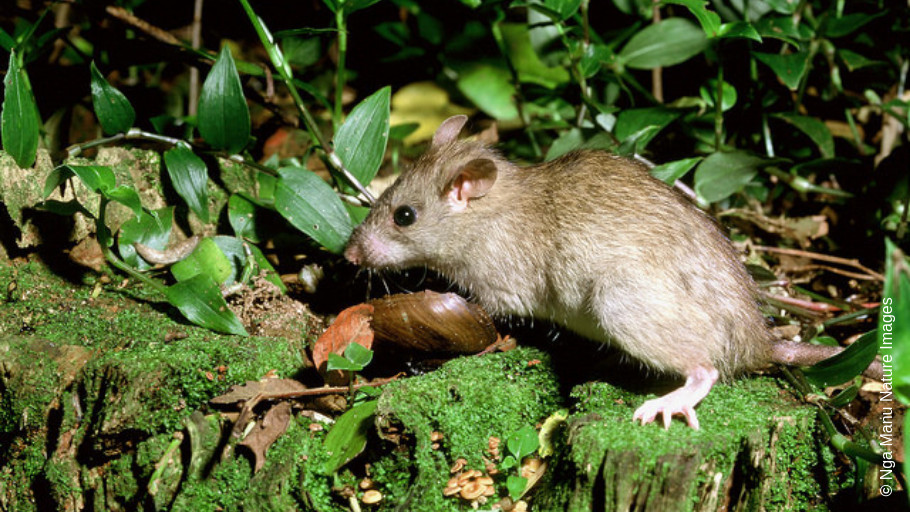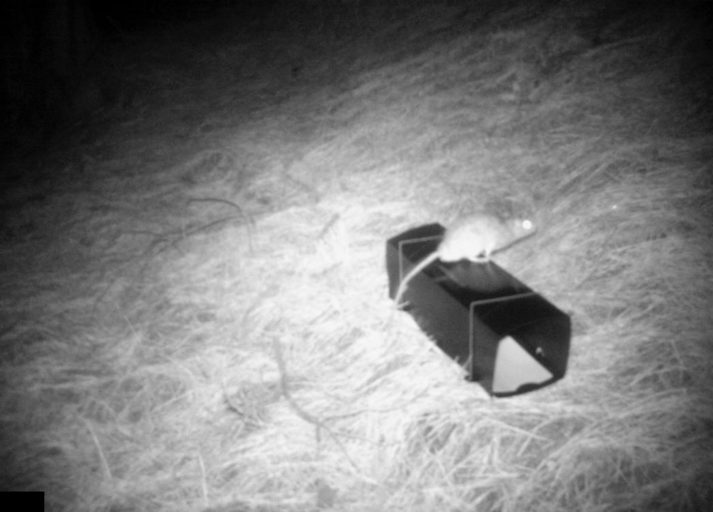How far might young rats disperse if they find themselves in a place with few other rat competitors? It’s an important question, with implications for deciding what surveillance is needed to detect invasions in predator-free islands, sanctuaries and ultimately, large predator-free mainland areas.

But to find out how far rats disperse you need to release some into the wild and watch what happens – then be able to catch them again. The last thing scientists want to do in such a situation is to help wild rats to colonise an area of hard-won, low rat density forest.
That was the challenge facing researchers Helen Nathan, Tom Agnew and Nick Mulgan from ZIP (Zero Invasive Predators) who report on the results of their study in the New Zealand Journal of Ecology.
“The dispersal process is a poorly understood aspect of animal behaviour, largely due to the difficulty of collecting empirical data. Here, we report on a field study aimed at measuring post-weaning movement distances of juvenile ship rats (Rattus rattus) and their mother away from a known natal nest site in an area with low conspecific population density [very few other rats].”
Finding a single rat intruder in a large area like a sanctuary or island is a bit of a needle-in-a-haystack task. The researchers were interested in finding alternative ways to manage incursions, involving low numbers rather than a single individual.
“The movement behaviour of invasive species at low density is of particular interest, as it can inform design of surveillance arrays to detect incursion into predator-free areas. Detecting a single invading individual requires intensive effort. An alternative approach is to focus on detecting newly established breeding populations, while they are still spatially-restricted and able to be eliminated with timely and effective incursion response.”
“Given that impacts on prey species are generally correlated with predator density, a limited number of ship rats in a spatially-restricted area of an otherwise predator-free landscape would likely cause minimal ecological damage to healthy native species populations under most circumstances. The critical aim is therefore to prevent the re-establishment of a widespread adult breeding population.”
To assess whether this approach would work, it is necessary to know what distance rats are likely to disperse.
“Empirical measurements of post-weaning ship rat movement distances are needed to evaluate the viability of this approach, especially in low to zero population density environments. It was our aim to provide measurements of this kind by simulating an invasion by a pregnant female ship rat into an area recently treated with 1080 (sodium fluroacetate). We expected that, as a unit, a mother rat with a litter of pups would be easier to detect than a single invader for two main reasons:
- there would be more individual animals to be detected, and
- the spatial extent of the invasion would be larger due to the juveniles being expected to disperse away from the mother’s range and each other as they attained maturity.”
First the researchers needed to find an area of forest suitable for rats which had very few rats living there.
“The trial took place in beech-kāmahi forest at the confluence of the Jackson and Arawhata rivers in South-Westland, New Zealand. The Jackson-Arawhata site had been subject to a trial of a novel 1080 prescription, in which 2300 hectare was aerially treated with 1080 on 7 July 2017. Subsequently, a 394 hectare core area within the treated zone was intensively monitored over 55 nights with no rat sign detected.”
The reason for choosing a mother and her young offspring is that other researchers, including Dr Kim King, have previously shown that juvenile rats are active explorers and dispersers.
“King et al. (2011) used a removal experiment to study the reinvasion of forest fragments by ship rats. Marked individuals re-colonised eradicated fragments from the outside within a few days. Importantly, the age and sex ratios of invading rats were significantly skewed towards young male animals, with few older breeding females colonising fragments from the outside. Nevertheless, despite our comparatively thorough knowledge of dispersal and movement behaviour in ship rats, there are few, if any, empirical measurements of distances moved by juveniles away from a known natal nest site.”
A biomarker were used to identify the rats once they were released. Rhodamine B makes a persistent stain in growing hair tissue, which is visible under a fluorescence microscope
“Wild-captured male and female ship rats (sourced from Kaituna Valley Forest Reserve, Banks Peninsula) were paired at the ZIP captive animal facility in Lincoln. All rats were fed on a diet of laboratory rodent pellets, supplemented daily with food items such as seed mix and fresh fruit and vegetables. A litter of seven pups was born to a female on 8 August 2017. The mother and her litter were transported by road to the ZIP field staff accommodation at Haast on 16 August and were cared for in place by ZIP staff.”
“A 20 g ball of peanut butter, seed mix and oats containing 0.1% Rhodamine B biomarker dye was fed to the mother and pups on three occasions, when the pups were 12, 16 and 18 days old. A collar-mounted VHF radio-transmitter weighing 7.75 g was attached to the mother on 27 August (4.5% body weight). On 30 August, the mother and her litter were carried into the field site in a secure nest box and placed at a central location in the study area.”
The behaviour of the mother and her offspring was monitored for 12 weeks.

“An array of non-lethal detection devices was laid out along pre-existing monitoring lines that had been used to measure outcomes of the July 2017 1080 treatment. The initial detection area was an irregular polygon shape (due to unsafe access to certain areas) covering an area of 236 ha, with the release site located centrally in this area. As the trial progressed, we progressively extended the monitored area with the intention of monitoring outside of the expanding movements of the mother and all juveniles, and in the final configuration a total area of 300 ha was being monitored.”
The team also attempted to locate the mother by radio-tracking to her daytime den site at least once per week between 1 September and 16 October, as weather allowed.
Having allowed the mother and her offspring to disperse, the rats then needed to be trapped and positively identified.
“Kill traps were deployed progressively throughout the trial. An additional 119 T-Rex traps in tunnels were deployed progressively from 30 September, at which point the rat pups were 53 days old (34 days since last access to RB). Our intention in beginning trapping at this stage was to allow ample opportunity to trap all juveniles before they were 90 days old; the earliest point at which they may have become sexually mature. Additionally, we expected RB marking to become increasingly unreliable with time elapsed since last access to the biomarker.”
“From 30 October, a further 131 T-Rex traps were deployed on the existing 100 × 50 m detection array. Instead of being placed in tunnels, these traps were nailed directly onto trees at 1.2 m height above-ground and lured with Nutella. In addition, in the near vicinity of the release site, 44 tree-mounted traps were set 20 m away from existing stations and lured with Colby cheese (Mainland Ltd.) to provide intensive trap density and an alternative lure in this area (9.5 ha coverage).”

All rats caught in kill traps were kept and tested for bio-marker ingestion.
“A sample of 8−12 whiskers was plucked from each rat, dry-mounted on a microscope slide under a coverslip and examined with a fluorescence microscope. Final capture locations ranged up to 675 m from the release location for the juveniles, with 796 m between known siblings. The total range length for the mother exceeded 1.5 km.”
“Although ship rats are weaned between 21−28 days old, all available location data for the mother suggest that she remained in the near vicinity of the release site until her litter were around 35−40 days old. This pattern is consistent with what little information is available on interactions between ship rat mothers and their offspring in the wild. When the mother eventually did move away from the release site, she made a long-distance movement of 595 m to a new centre of activity. Average ship rat home range lengths are in the order of 103−200 m for females and 159−550 m for males in New Zealand radio-tracking studies in forest. Thus, a movement of nearly 600 m exceeds typical home-ranging behaviour (particularly of females) and resembles the exploratory behaviour of translocated rodents in the absence of conspecifics.”
So how does this information relate to a surveillance strategy for predator-free areas?
“Although we found no evidence that the dispersal extent of a rat litter aged 90 days exceeds that of an individual adult invader, the presence of multiple individuals in a landscape increases the likelihood that at least one will be detected. The concept of an efficient landscape-scale detection strategy targeted to breeding events therefore warrants further investigation. Such a strategy could rely on sparsely deployed detection devices intercepting at least one of an invading family and alerting managers immediately via an automated reporting system, triggering a rapid response to remove the nascent population while it is still restricted to a small area within the larger predator-free landscape.”
“Clearly, the efficiency of this strategy is critically dependent on the rates of reinvasion and breeding events at a particular site, as well as the speed and social acceptability of repeated response actions. We envisage that a family-based detection strategy will be most suited to large-scale mainland areas where intensive surveillance would be prohibitively expensive and logistically difficult to achieve, and where reinvasion is infrequent due to strong protection at its boundaries; for instance significant natural barriers, or an intensive ‘virtual barrier’ of trapping. We anticipate that sites meeting these criteria will become increasingly common as New Zealand progresses towards its goal to be predator-free by 2050.”
The full research report is published in the New Zealand Journal of Ecology and is freely available online.

